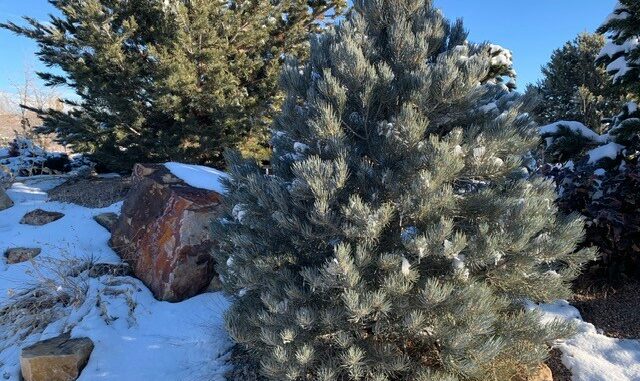

by Bryan Fischer, Horticulturist, Gardens on Spring Creek
Evolving considerably earlier than flowering plants (angiosperms), conifers represent a long-lived and successful lineage of trees classified as gymnosperms. Gymnosperms were among the first true seed-bearing plants and evolved before specialized pollinators existed, so they are typically wind-pollinated. Seeds on these plants are produced between or on scale-like structures (think pine cone scales), rather than in fully enclosed structures, like tomato fruits. Gymnosperm, in fact, is Greek for “naked seeds,” so just imagine what that might imply for the origin of the word “gymnasium” …
Long-lived, adaptable and attractive year-round, conifers represent a silver bullet of sorts for our Colorado gardens. Sadly, the overuse of just a few species and cultivars of these plants has given them a bad name. Don’t be put off – judicious use of conifers makes perennial plantings “pop” and provides structural bones during the fall and winter months. Below, find a selection of underused, adapted, and attractive conifers appropriate for gardens in our region:
With bark that exfoliates in camouflage-patterned chunks of metallic greens, browns, and ambers, Pinus bungeana makes an exceptionally interesting bed anchor. Slow growing, these trees form rounded specimens growing to 15 – 30 feet tall over decades. I like to skirt them with vivid perennials, like light purple Salvia ringens. A dark backdrop makes the Salvia’s flowers more visible, and the herbaceous foliage can be cut back before winter to show off the tree’s one-of-a-kind bark. Pruning from a young age is the best way to ensure their bark remains visible later in life.
Narrower spaces can easily be accommodated with the upright forms of ‘Slim Whitey’ Bosnian pine (now Pinus heldreichii; formerly Pinus leucodermis), or ‘Chalet’ Swiss stone pine (Pinus cembra). Both remain less than six feet wide and attain modest heights. After over a decade in our Rock Garden, neither has exceeded 15 feet. P. cembra ‘Chalet’ remains a personal favorite of mine, with dense, richly textured foliage.
For small spaces, or to preserve a vista, dwarf conifers represent the best option of the group. Diversity can be found at local nurseries, but origin matters: locally grafted trees are more likely to succeed. Large growers, often on the West Coast, graft onto rootstocks that aren’t well-adapted to our region, so ask for regionally-produced stock at your local nursery.
Absolutely smitten with Pinus densiflora ‘Low Glow’, I managed to score one for my new yard this year. With needles that are perpetually spring-green, this plant brightens my garden. I’m excited to try apricot-orange Papaver spicatum in front for an eye-popping color duo. Slow growing, P. ‘Low Glow’, put on only a few inches of growth annually. They end up wider than they are tall (up to five feet across). Equally tidy and more petite, single-needle piñon (Pinus monophylla) is a small cousin to the two-needle piñon we are all familiar with. P. monophylla comes in a variety of colors and shapes, from forest green to dusty blue and round to teardrop.
Requiring minimal care after establishment and tolerating periodic drought, conifers make wise additions to our gardens, imbuing them with structure, winter interest, and texture that herbaceous perennials just can’t match. Just be sure to branch out from junipers and spruce!
Support Northern Colorado Journalism
Show your support for North Forty News by helping us produce more content. It's a kind and simple gesture that will help us continue to bring more content to you.
BONUS - Donors get a link in their receipt to sign up for our once-per-week instant text messaging alert. Get your e-copy of North Forty News the moment it is released!
Click to Donate
